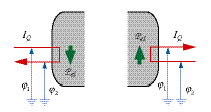4. Energy in Electrical Processes and Systems | | 
| | Apart from being conserved, energy has three main properties: It can be stored, it can flow or be transported, and it can be released or used in processes (see Chapter E). This is true for energy in electrical systems as well. Energy in electrical processes. The waterfall image of processes applies (Figure 1): The rate at which energy is released or used in an electric process is proportional to the product of voltage (potential difference) and electric current: P_el is called the (electric) power of a process (the rate at which energy is released in a voluntary process or used in an involuntary process). delta_phi_el is the electric potential difference through which we have an electric current I_Q. Energy transport with conductive electric transports. If electric charge flows conductively into or out of a system, and the flow is associated with a potential phi_el (Figure 2), there is an associated energy current I_W,el of Energy storage. Energy can be stored in electrical systems together with electric charge (in fact, it is said to be stored in the electric field associated with the electrical state of the system). The simplest example is a capacitor where the quantity of energy stored is related to the charge and the voltage of the capacitor. The precise relation depends upon the particular properties of the storage elements, so there is no single relation that can be used for energy storage (see Chapter E: Processes and Energy for more information). |

Figure 1

Figure 2
| | |

